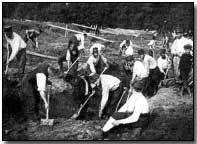Encyclopedia - Trench Latrines
 Comprising pits dug to a
depth of 4-6 feet and usually approached by a short trench either to the
rear of the line (or, in the case of the front trench, curiously in advance:
presumably to discourage any inclination to linger), latrines provided an
all-pervading smell which came to be firmly associated with
trench
warfare in the minds of veterans.
Comprising pits dug to a
depth of 4-6 feet and usually approached by a short trench either to the
rear of the line (or, in the case of the front trench, curiously in advance:
presumably to discourage any inclination to linger), latrines provided an
all-pervading smell which came to be firmly associated with
trench
warfare in the minds of veterans.
Latrines were not meant to be permanent. Battalions leaving the line were tasked with filling in their own latrines and preparing fresh pits for the incoming relieving force. On many occasions however buckets and even biscuit tins would be used in place of deep pits; these would be emptied on a daily basis. Similarly shell holes were placed to effective use as toilets.
Each company would typically assign two men to sanitary duties, a much-despised task. It would be their responsibility to maintain latrines in good order. Inevitably given the widespread distaste for the job men would often be punished for breaches of the army code by being assigned sanitary duty.
Aside from the inevitable smell associated with faeces the area of the latrine was heavily dosed with quick-lime: the combined smell was formidably powerful (and repulsive). Men seldom spent much time visiting the local latrine. Not only was the smell deemed offensive but it was also considered a dangerous place to linger. Enemy forces would often detect increased activity in such sites and subject the area to artillery bombardment.
Nevertheless commanding officers were almost always strict in insisting that troops use designated latrines rather than communication trenches (for example) for fear of the possibility of disease.
'White Star' was a German mixture of chlorine and phosgene gas, so-named on account of the identification marking painted on the delivery shell casing.
- Did you know?
